When and how to properly plant onion sets on a head in open ground, what are the basic rules for caring for this crop - such questions concern many novice gardeners. Young onion sets are used as an additive in various dishes. It is also used as seedlings, and also for planting on a head in open ground. This plant is universal both for planting in the ground and for growing in greenhouse conditions; it can even be grown on the balcony.
In greenhouses and solariums, vegetable crops can only be grown by planting young plants with well-developed roots. Through seedlings you can grow a variety of vegetables: tomatoes, peppers, eggplants, white cabbage, red cabbage, cauliflower, green lettuce, greenhouse, onions, asparagus, celery root, etc.
When are the seeds sown for sowing?
Sowing is carried out in a specially designed room. It should be clean, sanitized and bright. The area intended for seedling production must provide good climate control - temperature, humidity and ventilation. For greenhouse crops, solariums and early crops in the field, seedlings are grown in warm or warm greenhouses, and for summer and autumn crops - in heated or partially unheated, semi-indoor or outdoor pools.
Young onion sets are valued for their rich composition, containing many useful vitamins and microelements. It is added to salads and vegetable soups, used as an additive for casseroles and other vegetable and meat dishes. When is the best time to plant onion sets on a head in open ground, you need to know in order to get the most positive result from planting it and please yourself not only with young, vitamin-rich greens, but also prepare seed for planting it next year.
Since the seedlings are produced in controlled areas, they occur according to the intended planting time in the garden. For example, if we are producing seedlings for a seedling plant that is planted in the garden approximately 60 days after sowing, we calculate the sowing time, which in this case would be late February - early March.
Only in this way will the seeds germinate and be ready to plant in the garden in the spring. Installation of warm floodlights begins in January and continues in February and March. Cold heaths use only the heat of the sun and are specifically designed to produce seedlings for late planting vegetables.
The benefits of culture
Onions are a biennial plant. In the first year of planting, the seeds grow and produce onion sets, which have a round or oval shape. The color of young bulbs varies, depending on the plant variety. When onions are planted in the first year, greenery grows; throughout the season, bulbs are formed, which are gradually overgrown with leaf blades. The next year of planting, these bulbs are used as seed material to obtain the onion.
What kind of soil should it be?
Sowing seedlings is not a complicated operation, but this does not mean that it should be done casually or without taking into account some clear rules. If we follow these rules, we are sure to have vibrant and healthy plants. Here are the principles to consider.
What containers do we use for seedlings?
For seedlings we use wood, sometimes concrete or brick. Typically, by hedges we mean spaces that are specially designed, heated, exposed to light. You can also use food cubes to produce seedlings, plastic pots, as well as alveolar trays or slabs. The latter are often used and are modern method, used by vegetable growers.
Onion sets are a great addition to spring and summer dishes and are often used in many dishes. It is rich in retinol, B vitamins, Ascorbic acid, vitamin E, potassium, calcium and vitamin PP. In addition, it contains essential oils that help prevent the appearance of various pathogens. Onions also contain flavonoids and many other beneficial substances.
Expandable polystyrene alveolates for seedlings can be used both in greenhouses and in sunflower and field crops. Moreover, if used correctly, they can last for years. You can see in this article more details about the benefits of alveolar rash for seedlings.
How to prepare soil for seedlings
Soil suitable for garden beds is actually a mixture of several soil types. Each crop has specific requirements regarding the type of soil that grows best. Heating the baby box is composed of organic materials, during the process of fermentation and decomposition, generating heat. We are talking about biofuels. The main fuel material used is horse manure, cattle, sheep and pigs.
How to process seed material
 Processing of the material before planting in the ground is carried out two weeks in order to disinfect the seeds from various diseases and pests to protect the plant from the appearance of shoots, to enable it to grow well and quickly. To do this, two weeks before planting, the seedlings are heated for at least eight hours in water heated to forty degrees.
Processing of the material before planting in the ground is carried out two weeks in order to disinfect the seeds from various diseases and pests to protect the plant from the appearance of shoots, to enable it to grow well and quickly. To do this, two weeks before planting, the seedlings are heated for at least eight hours in water heated to forty degrees.
What soil should I use for seedlings?
However, the soil should be placed in a chemical disinfectant shelter to prevent disease. For garden beds, various soil mixtures are used - celery soil, garden soil, garden soil, leaf compost soil. When preparing mixtures of soil used in beds, river sand and Various types compost. Mixtures vary depending on the crop. Thus, tomatoes, seeded, soil beds of the ideal garden soil consists of 50%, 25% and 25% ground celery sand.
When preparing earth mixtures, add 3 kg of ammonium nitrate, 5 kg of superphosphate and 1 kg of potassium salt to each cubic meter of the mixture. The hearths are setting. Selected as seeds and disinfection according to the characteristics of each cultivation time. Sowing is done in a loose, well-leveled substrate. Sow manually by spreading, if the seedlings are transplanted to be marked in advance or seedlings with wooden markers at a distance of 8-12 cm, if the seedlings are not transplanted.
The second treatment of the bulbs is carried out a day before planting the onion sets. In order to speed up the growth of the onions, they are soaked for a day in heated water. When the seeds have been in water, they are dried and dipped for 10 minutes in a weak solution of potassium permanganate (video).
Before soaking, the sets are sorted, the peeled husks are removed from them, and they are sorted by size. Those bulbs on which green sprouts have appeared are rejected and thrown away. Next, cut off the upper neck of the bulbs using scissors. The roots are not touched. These manipulations may not be carried out, but experienced gardeners It is advised to adhere to all planting algorithms for better growth and development of planting material. When the top is cut off, the feather grows faster and smoother, without bending.
The seeds are placed in beds and covered with a layer of soil of more than 1 cm, and when moist, pressing it down a little. After sowing and before emergence, the seedlings were covered plastic film, which should maintain optimal heat for germination. 3-4 days after sowing, the film is removed within 5-6 hours in the warm time of the day and the evening cover of the new sowing.
Operations for caring for seedlings
After sowing the seedlings will be taken care of so we get healthy plants to give us quality vegetables. Pure water used to water the Earth's temperature. The amount of water used for irrigation depends on the characteristics of the crushed mixture and the age of the seedlings.
When the preparation of the bulbs is completed, it is necessary to fertilize the crop. For this, complex fertilizer is used, the proportions are one tablespoon per bucket of water. Leave the onion sets in this solution overnight. In order to prevent the appearance and development of the onion fly and, as a result, the death of the plant, it is recommended to immerse the onion in a salt solution and keep it there for several hours.
Water during the hottest hours of the day. Temperature and humidity for plant growth depends on each crop. Transplant seedlings are produced by transplanting seedlings over long distances in order to provide more feeding space. In seedlings, diseased plants are poorly developed and removed, and determine branching by breaking the root tip more strongly. This method is particularly suitable for tomatoes, peppers, eggplants, cabbage and early cauliflower. Transplanters optimal time when the plant produces 1-2 leaves.
Leave the seedlings in shade for 1-2 days to ensure good traction. After 3-4 days, transplant controlled investments and fill in any gaps. For crops in greenhouses and greenhouses, pots or seedlings are pricked in nutrient cubes, while seedlings are collected for field crops in solariums of heated cubes placed on the ground, directly on the first layer prepared for this purpose, or in greenhouses. As for the transplanting distances and sizes in the cubes or pots that are chosen, they differ from one plant to another.
To prevent fungal infections, planting material is immersed in a weak solution of copper sulfate for 15 minutes. Potassium permanganate can be used instead of copper sulfate. This method has been tested for years and has proven its effectiveness in combating many diseases of vegetable crops. It is not at all necessary to keep the planting material in all of the listed solutions. You need to choose the most suitable option for yourself and use it to prevent diseases healthy vegetable and to get a good harvest.
The repellent depth for most vegetables is 0.5-1 cm greater than the depth at which the plants were in the sow, and only lettuce, celery and ghoulia replicate at the same depth. The seedlings are thoroughly wetted in advance so that they can be easily removed from the seed. Plants are sorted and stored only in vigorous and healthy specimens.
Prevention and control of diseases and pests when it comes to planting includes, in addition to general hygiene measures - disinfection, work spaces and tools - the introduction of periodic treatments at intervals of 7-10 days with fungicides. At the same time, the seedlings are folded or treated with herbicides.
What kind of soil should it be?
To plant this vegetable crop, there are certain soil requirements. Soil saturated with humus or black soil brings good harvest. The beds must be laid out in well-lit areas, maintaining a distance between the holes, this is the prevention of fungal diseases of the plant. Before planting the bulbs, it is recommended to thoroughly loosen the soil and level it, moisten it if necessary. Removal of weeds is mandatory.
Fertilization of seedlings is carried out 1-2 times using soil or foliar fertilizers. In terms of mineral needs, seedlings need nitrogen, phosphorus and potassium fertilizers. For planting, only well-developed seedlings are used for good start for a strong and healthy plant. 4-7 days before planting, it is recommended to “start” fertilization with calcium nitrate, which ensures a supply of minerals on the plant after planting. Phytosanitary treatment can be applied the day before planting, and 24 hours before planting, watering until saturation is applied, which will facilitate the removal of seedlings.
The plant should not be planted in acidic soil. Best conditions for it are light soil or black soil with the addition of peat.
When to plant a plant in open soil
 The most suitable days for planting onion sets for greens are the last days of April. You can plant earlier, since the green feather appears already at two degrees Celsius. But if there are still frosts, it is better not to rush, since the crop does not tolerate temperatures below zero. They may survive, but will become prone to fungal diseases.
The most suitable days for planting onion sets for greens are the last days of April. You can plant earlier, since the green feather appears already at two degrees Celsius. But if there are still frosts, it is better not to rush, since the crop does not tolerate temperatures below zero. They may survive, but will become prone to fungal diseases.
When sowing vegetable seedlings
Vegetables intended for autumn consumption - cabbage, cauliflower, gulia - are planted in late June and early July, and lettuce is planted in both spring and summer. It can be applied to tomatoes, peppers, eggplants, onions, garlic, etc. The appropriate age for planting depends on the crop. At the same time, the development degree of the plant is also being carried out. The crop is ready for planting when it has minimum height 15 cm, has several leaves.
Why should we keep this in mind before boarding?
The crop is ready for planting if it is vigorous, thick and short, has a well-developed root system, and has buds formed at the first inflorescence. Planting seedlings in the field should be done on calm days, without wind, but without strong sunlight.
The suitable temperature for growing onions for greens is 10-15 degrees above zero, and for bulbs to form - 15-21 degrees. The crop can survive zero temperatures if it does not last long (morning frosts or when frost is in the air and does not fall to the ground). If created suitable conditions for cultivation, the first shoots appear after ten days, and green feathers can be eaten after three weeks.
Conditions for planting crops
Planting planting material of this plant Possibly after cucumbers and legumes. There is no need to enter nitrogen fertilizers. It is not recommended to plant onions if parsley, corn, nightshade and cruciferous vegetables were previously planted in this area. You cannot plant onions in the same area for more than three years. This can provoke the risk of diseases and various pests, and the appearance of many weeds.
It is not recommended to plant onions after potatoes, beets and carrots. After harvesting, it is necessary to carefully destroy all weeds. Before planting, it is necessary to loosen the soil and level it. It is imperative to eliminate weeds for the entire period of crop growth. Watering must be done when the bulb is forming.
It is not advisable to irrigate the soil later. Bulbs do not like high humidity. Since their root system is located too close to the surface of the earth, when watering it is necessary to irrigate it to a depth of no more than 15 centimeters. This will allow the moisture to be evenly distributed and not stagnate, causing the appearance of fungus and other problems.
Knowing how and when to plant onion sets correctly, knowing the basic rules of care and watering, you can prevent the development of vegetable diseases and get a good harvest.
Onions are no longer exotic summer cottage, rather, on the contrary, it’s strange when it’s not there. Despite its wide distribution and popularity, not all gardeners know how to grow it. This is a rather capricious crop and any deviation in agricultural technology leads to a deterioration in the quality of the crop. Excessively “evil” onions grow when there is a lack of moisture at the beginning of the growing season, a small head is formed when planting is thickened and at the wrong depth, non-compliance with crop rotation and violation of care rules leads to the development of diseases and affects keeping quality.
Often, summer residents receive a harvest, half of which does not survive until mid-winter, and the other half is only suitable for borscht due to its pronounced spiciness. What features need to be taken into account in order to plant onions correctly and avoid many problems?
Onions love illuminated areas and do not tolerate lowlands with heavy, waterlogged soils. Cabbage, cucumber and nightshade will be good predecessors for it. These crops do not have common pests and diseases with onions, and since their cultivation is accompanied by the introduction of high doses of organic and mineral fertilizers, then the soil remains quite nutritious.
Onions can also come after zucchini and peas, but it is undesirable for them to occupy areas that were previously under carrots, since fresh organic matter is not added to this crop, and onions require fertile soil. Also, the area after it is vacated late, you may not have time to prepare it for a new planting. You can plant carrots after onions; joint plantings are good. close location beds (they repel pests from each other).
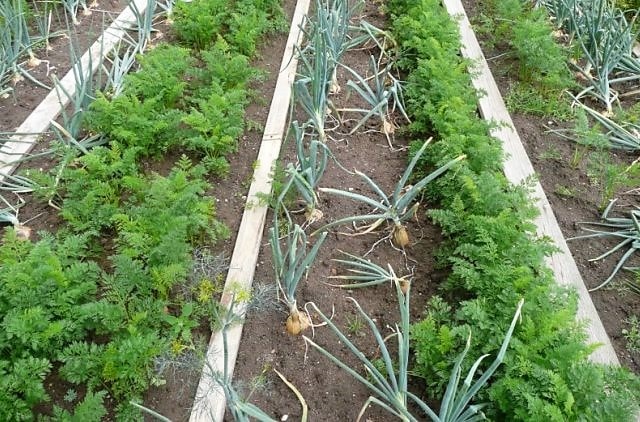
The plant can be returned to its original place no earlier than after 3 years, and in case of high disease damage - only after 5 years. Planting onions on a head in the spring should be done in loose and moderately moist soil, so in the fall the area should be dug up with a shovel, and in the spring it should only be harrowed with a rake and leveled.
If necessary, compost or humus and phosphorus-potassium fertilizers are added in the fall. To neutralize the soil solution on acidic soils, add chalk or lime. It is recommended to occupy areas where fresh manure was applied with onion plants only for the 2nd year.
In poorly heated areas with heavy clay soil In the fall, wide ridges are cut into which planting will take place.
When do you plant onions on the head?
The exact planting dates are determined by prevailing weather conditions and ground temperature. Onions are a cold-resistant crop, but when planted in cold soil they will bolt, which will reduce the quality of the harvest.
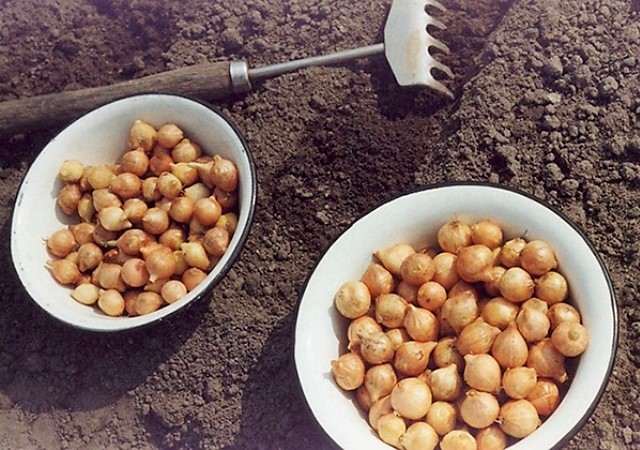
On the other hand, the procedure must be completed when there is still a supply of moisture in the soil, the needs of which are great for onions at the beginning of growth. And the relatively long growing season of this crop does not forgive delay.
Preparation of planting material
Planting material (seeds) stored warmly (18-20ºC with a humidity of 60-70%) does not require any procedures to activate growth processes. A week before planting, it is sorted out, discarding dried, sprouted and rotting bulbs, and sorted, dividing into 2-3 fractions.
It is recommended to sow the smallest fraction (diameter less than 1.5 cm) at an earlier date, as it does not produce shoots. Sewing from the middle fraction (diameter 1.5-2 cm) gives the best harvest, but provided that the planting is done in sufficiently warmed soil. Large onions (diameter more than 3 cm) can be used for growing onions for harvest or for obtaining turnips for canning, as they often shoot arrows, which affects keeping quality.
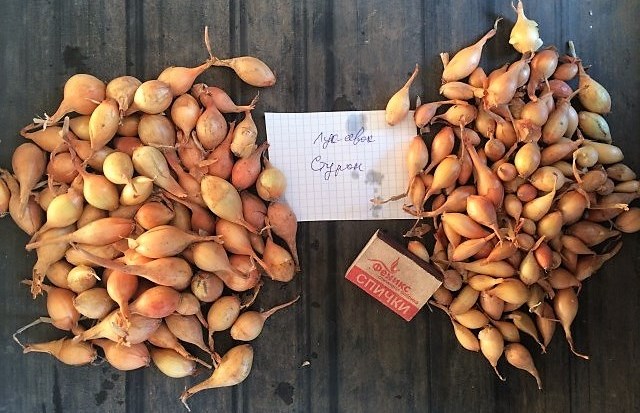
If the planting material was stored at low temperatures(in the attic, cellar, etc.), then 2 - 3 weeks before planting it must be transferred to warm room and dry (the container with the seeds can simply be placed near the radiator, but not very close).
The calibrated seed is heated at a temperature of 40ºC for 8 hours to destroy internal infection (can be placed on a battery in a cardboard box). Before planting, the bulbs are soaked in hot water for 12-24 hours. Instead of water, you can use a weakly concentrated solution of complex fertilizers.
Immediately before planting, the planting material is treated for 15 minutes with a pale solution of potassium permanganate or a fungicide (for example, copper sulfate). After treatment, rinsing in clean warm water is required.

Some summer residents trim the “tails” of the seedlings to speed up germination. However, such a procedure damages the protective barrier and opens the door to infection, so it is better to get by with soaking, which will already halve the time before germination.
Technique for planting onion sets
Shallow grooves are cut on the leveled bed. The distance between the grooves should be 15-20 cm to make it convenient to care for the plants. If the soil is not moist enough, the furrows are shed with water. Onions respond well to the addition of wood ash and sand into the furrows.
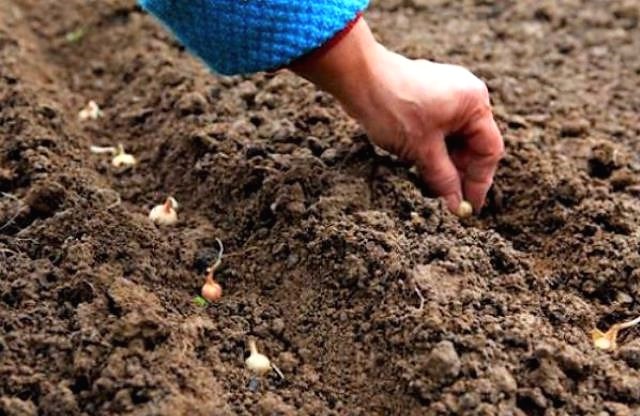
Treated seedlings can be planted in the prepared bed. The bulbs are buried with the bottom down to the “shoulders”, and then sprinkled with earth, so that a layer of 2 cm is formed on top. Surface plantings will give earlier shoots, but with this technique you will not be able to get a good turnip.
The sets in the row are placed at a distance of 6-10 cm (depending on the variety). Some summer residents advise planting it densely in a “snake” pattern in order to obtain not only bulbs, but also greenery from one bed. As the plants grow in the row, they are thinned out, removing the bulbs along with the feather. This method is convenient for a small garden bed, when you are sure that it will be thinned out in a timely manner.
How to grow a head from seeds in one season?
Growing onions for turnips in the Non-Black Earth Region, the Far East and Siberia occurs in a two-year culture, i.e., first a set is obtained from seeds, from which turnips are grown the next year. In the southern regions and central Russia, some sweet and semi-sharp varieties and hybrids can form a marketable bulb from seeds in one season. To get a turnip directly from seeds, you need to sow in early spring and winter or use seedlings.
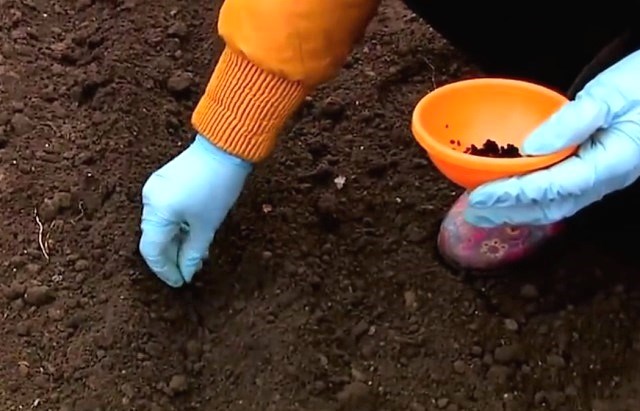
If weather conditions permit, onions can be sown at the end of April directly into open ground. To speed up seed germination, they must be placed in warm water or a solution of growth stimulants for 1-2 days.
It is better to sow on high ridges. Seeds are sown to a depth of about 2 cm, belt method with a distance between the ribbons of 20 cm. Thus, if the ridge is 1 meter wide, then 4-5 rows can be placed on it. The seedlings need regular watering and thinning twice. The first time is thinned out a few days after mass germination, leaving an interval of 2 cm between plants, and the second time - in the phase of 2-3 true leaves with an interval of 6 cm.
In winter, seeds are sown from late October to mid-November. Pre-winter sowing It is characterized by an increased seeding rate (3 times) and mulching of crops with peat. Shoots appear earlier, so the bulb ripens earlier.
Mostly sweet salad varieties are grown through seedlings. Sowing of seedlings in a heated greenhouse is carried out in early March. It is possible to grow seedlings at home, but only with sufficient lighting. When sown in nutrient soil, seedlings only require regular watering. Plants are planted in open ground at the age of 55 days (they should already have 3-4 true leaves). To do this, choose a cloudy day or evening. They are planted with a row spacing of 25 cm, with 6–8 cm between plants in a row.
The best varieties and hybrids
Onions are very sensitive to daylight hours, so for planting you need to choose only zoned varieties or achieve local selection. Varieties bred in the northern regions may not form a bulb at all in the south with short daylight hours. When creating your collection of favorites in the garden, include representatives from different groups. Spicy varieties are distinguished by high keeping quality and yield, while semi-sharp and sweet varieties have good taste.
A guaranteed harvest can be obtained by planting old local varieties. In different regions, Strigunovsky, Rostov local, Bessonovsky, Spassky, Mstersky, Pogarsky, Timiryazevsky received popular fame. They are zoned quite widely and are known among gardeners throughout Central Russia and beyond.
Of the widely zoned spicy varieties and hybrids, it is worth noting Golden Semko, Centurion and Stuttgarter Risen.
Golden Semko - early ripening with a large round golden bulb, which is formed in one season directly from seeds; gives high yield; cultivated in all regions of Russia.

Centurion - a low-shooting hybrid with a mid-early ripening period; the bulbs are golden, medium-sized, slightly elongated; resistant to diseases.

Stuttgarter Risen - mid-season with large, slightly flattened bulbs.
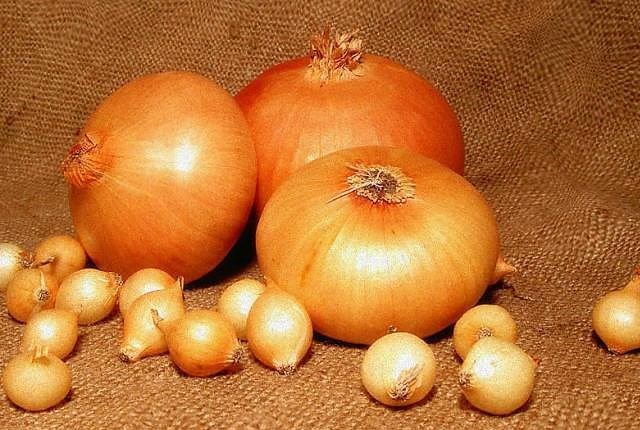
Peninsular varieties for Middle zone Russia: Zolotnichok, Odintsovets, Sputnik, Myachkovsky 300, Red Baron.
Zolotnichok - mid-early with golden rounded bulbs.
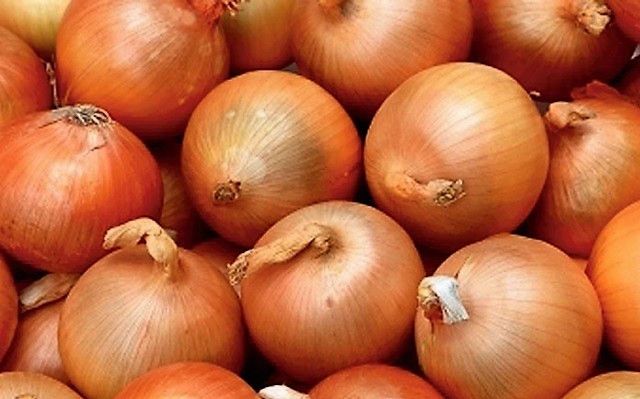
Myachkovsky 300 - early high-yielding with flattened yellow bulbs of medium size; Suitable for growing turnips directly from seeds.
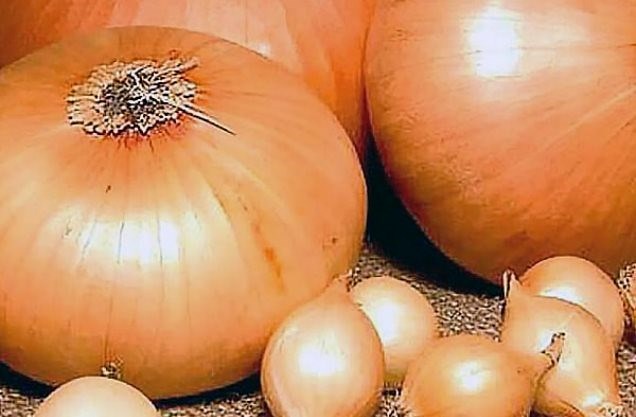
Red Baron - early date maturation; The bulbs are dark purple, round, weighing up to 150 g.
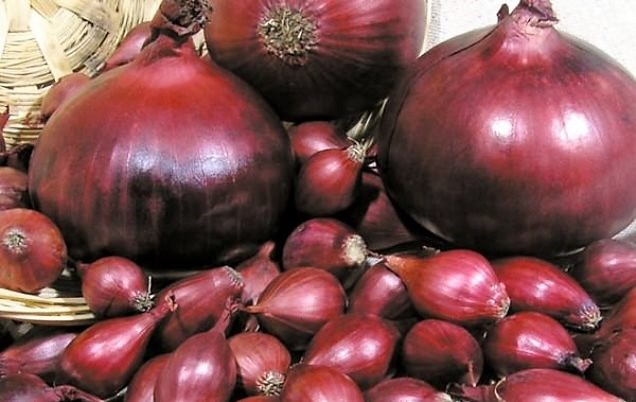
Good varieties and hybrids of sweet onions: Exhibition, Ritmo, Comet.
Exhibition - medium ripening with large oval yellow bulbs; suitable for growing as an annual crop from seeds; has high yield, but low shelf life.
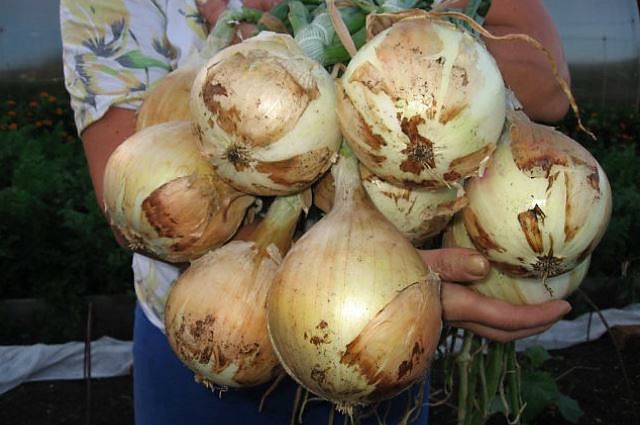
Comet - late ripening with large white bulbs; resistant to diseases and suitable for long-term storage.
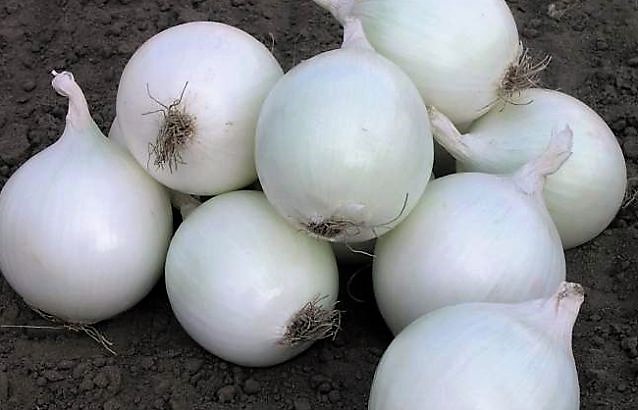
It can be difficult for beginning gardeners to decide which onion to plant. After all, not only taste and yield are important here, but also shelf life and disease resistance. Moreover, the same variety in different soil and climatic conditions can show different results. Therefore, select up to 5 different varieties in order to highlight your favorites in 2-3 seasons.
Subtleties of plant care
Young seedlings need regular (1-2 times a week) and moderate watering, followed by loosening the rows to restore root aeration. As the head begins to form, the frequency of watering is reduced, and a month before harvesting it is not carried out at all for successful ripening of the bulb. However, in case of severe drought, it is recommended to sprinkle with a small volume of water.

They pose a serious threat to seedlings weeds, so weeding must be timely. Hilling up of plants and close loosening is not allowed. Weeds in the row are removed manually so as not to damage the bulb with a weak root system.
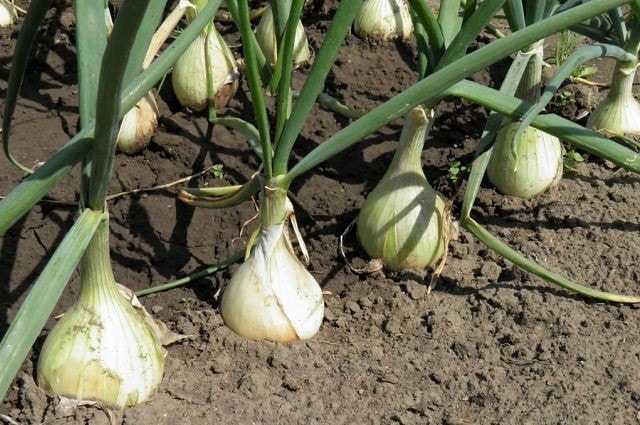
Many summer residents advise carrying out one or even two feedings per season. However, there is no need for them on fertile soils, filled with organic matter in the fall. On poor soils, the first fertilizing with liquid organic fertilizers(horse manure, bird droppings, mullein) is carried out approximately a month after planting. The second feeding is carried out during the period of turnip formation, using phosphorus-potassium fertilizers. To prevent root burns, fertilizing is carried out after moistening the soil and before watering.
